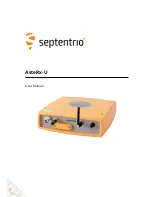
LEA-5, NEO-5, TIM-5H - Hardware Integration Manual
GPS.G5-MS5-09027-A2
Released
Design-in
Page 36 of 68
2.5.3
Antenna connection and grounding plane design
u-blox 5 modules can be connected to passive patch or active antennas. The RF connection is on the PCB and
connects the
RF_IN
pin with the antenna feed point or the signal pin of the connector, respectively. Figure 25
illustrates connection to a typical five-pin RF connector. One can see the improved shielding for digital lines as
discussed in the
GPS Antenna Application Note
[6]. Depending on the actual size of the ground area, additional
vias should be placed in the outer region. In particular, the edges of the ground area should be terminated with
a dense line of vias.
micro strip line
Optional active antenna supply
no crossing signal lines or
signal trace vias in this area
u-blox 5
module
Figure 25: Recommended layout (for exact pin orientation see data sheet)
As seen in Figure 25
an isolated ground area is created around and below the RF connection. This part of the
circuit MUST be kept as far from potential noise sources as possible. Make certain that no signal lines cross, and
that no signal trace vias appear at the PCB surface within the area of the red rectangle. The ground plane should
also be free of digital supply return currents in this area. On a multi layer board, the whole layer stack below the
RF connection should be kept free of digital lines. This is because even solid ground planes provide only limited
isolation.
The impedance of the antenna connection has to match the 50 Ohm impedance of the receiver. To achieve an
impedance of 50 Ohms, the width W of the micro strip has to be chosen depending on the dielectric thickness
H, the dielectric constant
r
of the dielectric material of the PCB and on the build-up of the PCB (see
Section 2.5.4
). Figure 26 shows two different builds: A 2 Layer PCB and a 4 Layer PCB. The reference ground
plane is in both designs on layer 2 (red). Therefore the effective thickness of the dielectric is different.
















































